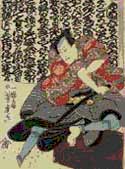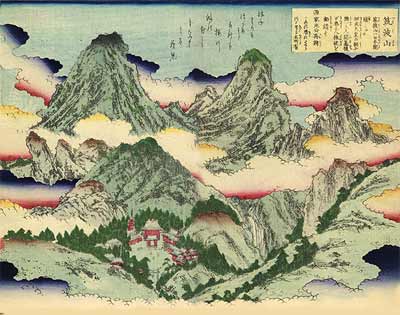Japanese Woodblock Prints
by Christopher Caile
 The
colorful Japanese woodblock prints (hanga) that we see today are the culmination
of centuries of development. Woodblock printing was originally developed
in China in the fourth century, AD, and came to Japan with the arrival
of Chinese and Korean Buddhist missionaries several hundred years later.
In Japan they were soon used to create simple Buddhist charms (sayings).
Their use was expanded later, in 1088, to print Buddhist scriptural narratives.
Thus, in Japan the use of woodblocks printing was initially confined to
temples and monasteries. It was not part of art and culture that flourished
in this period. The
colorful Japanese woodblock prints (hanga) that we see today are the culmination
of centuries of development. Woodblock printing was originally developed
in China in the fourth century, AD, and came to Japan with the arrival
of Chinese and Korean Buddhist missionaries several hundred years later.
In Japan they were soon used to create simple Buddhist charms (sayings).
Their use was expanded later, in 1088, to print Buddhist scriptural narratives.
Thus, in Japan the use of woodblocks printing was initially confined to
temples and monasteries. It was not part of art and culture that flourished
in this period.
A long period of feudal conflict, warfare and unrest emerged at the beginning
of the thirteenth century. A new military class of Samurai had arisen,
and the Imperial court was unable to control these independent warlords
in outlying regions. Rivalry over land and power led to centuries of military
conflict and civil war. But a much more subtle revolution was also underway.
Trade and commerce fueled the rise of a powerful mercantile class. The
very nature of power was shifting away from a feudal land based economy
supported by the force of arms.
Around 1600 the long period of civil war ended with Tokugawa consolidation
of power, and peace allowed the arts to again flourish. As samurai warlords
settled into their landed estates, they used artists and craftsman to
decorate their homes. But the mercantile class in Kyoto and elsewhere,
who largely had funded the wars, had different tastes, and their power
had grown to rival, if not surpass, that of the Samurai. They commissioned
non-traditional pictures, such as pretty courtesans and women. This was
the beginning of an important artistic class schism which led to the development
of woodblock prints as an art form.
The art form then received an important boost when the first Tokugawa
Shogun, Ieyasu Tokugawa (1542-1616), supported book production and helped
in the establishment of an arts center for arts and crafts.

Soon after simple black and white woodblock prints were incorporated
into books. By the mid-1600's color had appeared. Edo was the new administrative,
political and commercial capital whose citizens were cut off from the
traditional arts and the imperial court centered in Kyoto. A middle class
developed. The merchants class preferred more down-to-earth themes reflecting
their own lifestyle. They attended the Kabuki (meaning fashionable) theater
while the Samurai class patronized the more traditional Noh theater.
Then in 1657, a raging fire destroyed most of Edo and in its wake a new
form of cheap decoration, bought from publishers and street vendors, flourished:
stand along woodblock prints. Woodblock prints were cheap and could be
used to brighten screens and walls. They were bought from street vendors
and from publishing houses.
Hanga prints soon blossomed into intricate and rich multicolor compositions
illustrating the exotic Edo-period urban lifestyle known as the "Floating
World," or Ukiyo-e (uu-kee-yue-eh), a name by which this style
of prints became known. Inspired by forms of entertainment patroned by
the powerful Edo mercantile class, Ukiyo-e prints became the Hollywood
posters, pin-ups and erotica of the day. They portrayed the arts and Kabuki
theater, actors, courtesans, beautiful women, tea houses and brothels
-- all that comprised the fleeting moment of beauty.
When internal travel restrictions were lifted in the 1820's, a domestic
tourist market also developed. Interest blossomed in landscapes, such
as scenes of Mount Fuji, seascapes and landmarks. History and fictitious-historical
stories became a favorite subject in the Meiji era (the modern era from
1868-1912). Depicted were mythical, historic figures, heroic samurai legends
and great acts of valor, battle scenes and sumo wrestling. Many were violent
in nature, others done with humor, as tongue-in cheek parodies of classical
art forms (kano), while others were so romanticized that prints included
inscriptions informing the viewer of the scenes portrayed. In 1853, the
closed society of Japan was forcefully opened by American gunboats. Soon
afterward, Western trade with Japan began. In the port city of Yokahama
a market for woodblock prints developed among foreign visitors.
The earliest prints were in black and white, but soon the public demanded
color artwork. By the 1750s, hand coloring had evolved into sophisticated
full-color printing. Through an intricate process, artists' drawings were
translated by a master woodcutter and assistants into a master cherry
or other hard fine textured wood panel carved in relief. A black and white
print of the design was made from the master pane which was used to create
separate woodblocks, one for each color to appear in the print. These
were ultimately used to print the design in multiple colors. Technical
refinements allowing precise registration allowed simple four-color prints
to evolve into those with up to ten or twelve colors. The final composition
was entrusted to a master artisan for the multi-block impression process
of finished printing.
Many believe the myth that Europeans first became aware of this unique
art form because woodblock prints were used as wrappings on items arriving
in Europe from the Orient. In truth it was a French engraver who upon
coming across a wooblock print recognized its importance, and showed it
to friends. Later a shop was opened selling Japanese objects, including
woodblock prints. They soon became much in demand because of their sweeping
compositions, which were rich in color, designs and textures portrayed
without shadow. They also caught the interest of many Impressionists.
Monet, Degas, Van Gogh who were influenced by this genre of Japanese art.
Prints by Henri Toulouse-Lautrec, for example, have a Japanese woodblock
print quality, and Paul Gauguin's oil paintings of the South Seas use
a stylized Japanese woodblock method, using flat areas of bold color without
perspective. Today in the West, some woodblock prints, such as Fuji
in Clear Weather and The Great Wave off Kanagawa by Hokusai
and The Sudden Shower at Ohashi Bridge by Hiroshige are as recognizable
as works by Picasso or Renoir.
Unfortunately, contact with the West also had a negative effect on the
popularity of the woodblock art form. The Japanese developed an absorbing
interest in all things western, especially science and technology. Photography
captured the publics attention. Woodblock prints could not compete. Only
a few artists struggled to keep their woodblock print art alive, and the
art form never regained the popularity it once held.
|